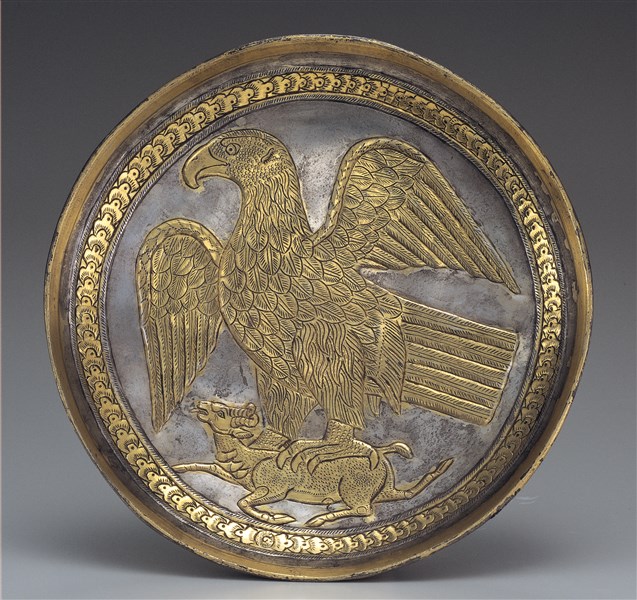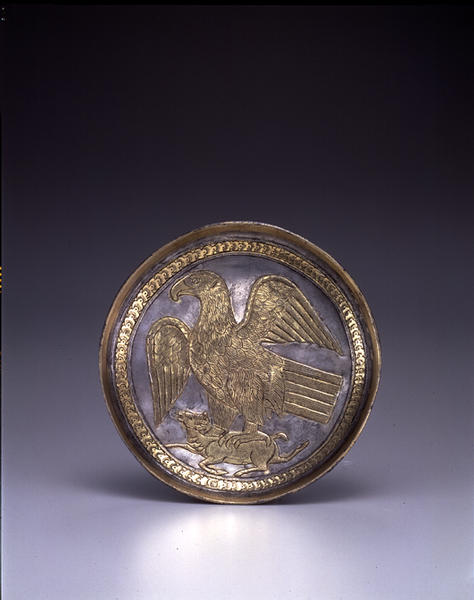Plate with a Raptor Attacking a Gazelle
- Greater Iran
- 7th - 8th century A.D.
- Silver gilt
- H-4.4 D-22
Catalogue Entry
At the center of this circular plate--which is set on a low foot ring--is a large, heraldic bird of prey attacking a gazelle. The raptor's wings are shown outstretched, as though it has just descended upon the substantially smaller animal, which it grasps in its talons. Struggling to escape, the gazelle seems to be pressed to the ground beneath the weight of the bird. The two animals and the surrounding border, which are all decorated with mercury gilding, appear in relief, the background having been carved away. Chased lines carefully delineate the different areas of the bird's plumage, while the gazelle's coat is indicated by dotted lines.
The motif of a bird of prey attacking a gazelle has a long history in the Near East, and on the most basic level it can be understood as a symbol of victory or power. In terms of style, the closest parallels for the decoration on this plate occur among several other vessels that are datable to the late Sasanian (sixth-mid-seventh century) or early Islamic (mid-seventh-eighth century) periods, in particular, a silver gilt plate in the Hermitage, attributed to the seventh or eighth century, on which a monumental bird of prey is likewise triumphantly perched atop a struggling gazelle that it clutches in its talons.1
The issue of the provenance and dating of such silver objects is a vexing one.2 Although the Sasanian dynasty came to an end in A.D. 651, following nearly two decades of struggle against the Muslim invaders, the total subjugation of the empire and its complete incorporation into the Islamic commonwealth took still longer. Even as the Islamic polity increasingly asserted control over Iran and the territories to its east, in the later seventh and eighth centuries the new religion and administration did not necessarily have an immediate impact on artistic production. Rather, many of the same forms and techniques must have continued to develop and evolve, even as much of the representational imagery gradually lost its original meaning.3 It seems likely that objects fashioned of silver, along with their associated styles, persisted as status symbols for the new aristocracy. It is therefore difficult to pinpoint where Sasanian art ends and Islamic art begins during the first century or more of Muslim rule in Iran.
Objects such as this Shumei silver plate, which belong to this transitional period, often have been characterized by scholars as "post-Sasanian" and/or "provincial" work, to distinguish them from the silver wares that were produced under the patronage of the Sasanian dynasty itself.4 While there is no denying the obvious connection with Sasanian art, in terms of the general style, technique, and form (see cat. nos. 50-52) these objects also stand in a definable relationship to Islamic art, whether or not such objects were produced for the new Arab, Muslim rulers. For example, the motif of the bird of prey was translated into a three-dimensional object in early Islamic times, as in a type of bronze aquamanile (water vessel) in the Hermitage, ascribed to Iraq or Iran, and dated by an Arabic inscription to the end of the eighth century.5 Such bronze raptors, which project a similar grandeur and dignity to those on the silver plates, attest to the continuing popularity of this motif, although it has lost some of its earlier charge as a symbol of power.
The study of decorative arts of the early Islamic period is one that is still in a rudimentary phase. Objects such as the Shumei plate, which clearly contributed to the formative process of early Islamic art, are vital to its understanding.
LK
1. Here, however, the direction of the animals and the gold and silver color scheme are reversed. See Trever and Lukonin 1987, no. 29; also no. 41. For several sixth-seventh century vases bearing the same motifs see Trever and Lukonin 1987, nos. 30-31, and Pope and Ackerman 1977, vol. 7, pl. 216c.
2. On this issue see Grabar 1967, pp. 18-84; see also Harper et al. 1978, pp. 24-78.
3. Grabar 1967, pp. 80-82.
4. Harper and Meyers 1981, pp. 5-13, 139-41; also, Grabar 1967, pp. 77-83, where the term "oriental" is used as well.
5. Dated 180 A.H./A.D. 796-97: see Ivanov 1990, no. 1. For a closely related aquamanile (or incense burner) in Berlin see Pope and Ackerman 1977, vol. 7, pl. 242, where it is called "post-Sasanian." Still further removed from its source is the bird of prey that occurs as the central motif on certain ceramic wares excavated at Nishapur and Samarkand, from the tenth century; here, the heraldic bird preserves little of its former grandeur. On one such Nishapur bowl a band of highly stylized gazelles encircles the bird, retaining some of their former association, but safe from the predator's grasp. For the Nishapur bowls see Wilkinson 1973, nos. 63a, 73a; and for a bowl from Samarkand see Paris 1992, no. 113. On this general issue see Grabar 1967, pp. 80-82.

